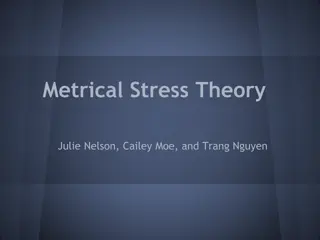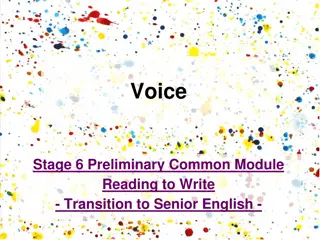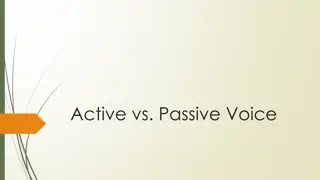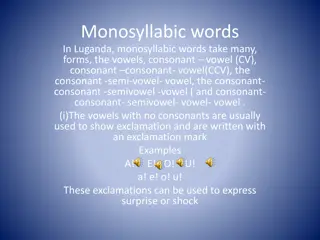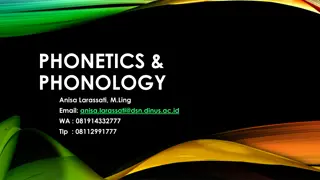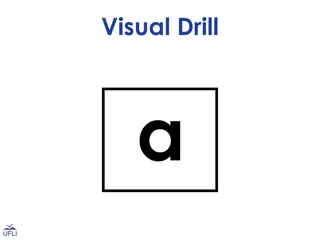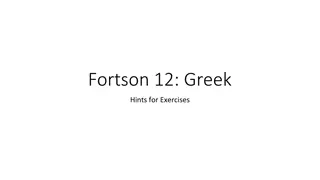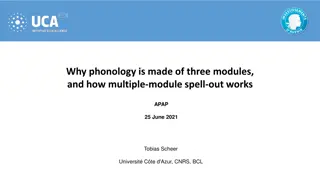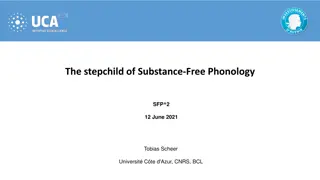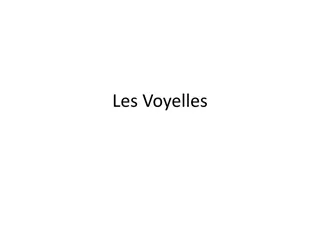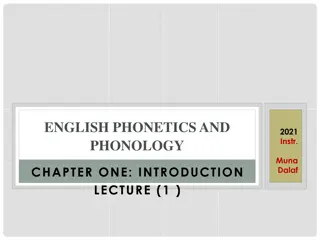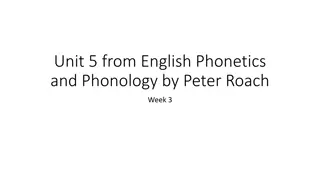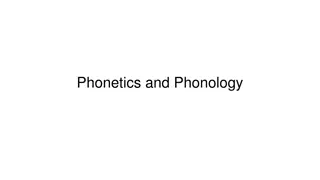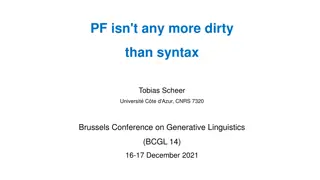Voice-Induced Vowel Lengthening in Phonology Research
Exploring the phenomenon of voice-induced vowel lengthening, this research delves into spontaneous vs. non-spontaneous voicing patterns and the documented transmission of voicing from vowels/sonorants to voiceless obstruents. The study discusses various theories on voice transmission from sonorants/vowels, including phonological considerations and post-phonological laryngeal properties. Voice-induced vowel lengthening is found to be a common occurrence in languages such as English, French, German, Russian, and Korean, with potential phonetic universality as a mechanical consequence of speech production.
Download Presentation

Please find below an Image/Link to download the presentation.
The content on the website is provided AS IS for your information and personal use only. It may not be sold, licensed, or shared on other websites without obtaining consent from the author. Download presentation by click this link. If you encounter any issues during the download, it is possible that the publisher has removed the file from their server.
E N D
Presentation Transcript
Voice-induced vowel lengthening Scheer, Tobias. 2017. Voice-induced vowel lengthening. Papers in Historical Phonology 2: 116-151. Fringe Workshop on Laryngeal Features in Historical Phonology at the Third Edinburgh Symposium on Historical Phonology Edinburgh, 29 November 2017 Tobias Scheer Universit C te d'Azur, CNRS
spontaneous vs. non-spontaneous voicing obstruents: non-spontaeous voicing phonologically active sonorants, vowels: spontaneous voicing phonologically inactive Chomsky & Halle (1968: 300f) solid and consensual empirical record for example, sonorants and vowels do not participate in final devoicing
spontaneous vs. non-spontaneous voicing documented transmission of voicing from vowels/sonorants to voiceless obstruents and vowels intervocalic voicing Cracow-Pozna voicing (external sandhi) ja[g] mo esz how can you voice-induced vowel lengthening Very common phenomena external sandhi voicing Polish Bethin (1984, 1992), Gussmann (1992), Rubach (1996), Cyran (2011, 2012, 2014) Wheeler (1986), Berm dez-Otero (2006) De Schutter & Taeldeman (1986) Kr mer (2000) Gussenhoven & Jacobs (2011: 196) Catalan West Flemish Breton Durham English
how to go about voice transmission from sonorants / vowels option 1: follow the surface all alternations involving sound are phonological in kind. Sure, sonorants and vowels do not have phonologically active voicing, except when they do. [sonorant voice] Rice & Avery (1989), Piggott (1992), Rice (1993), Avery & Idsardi (2001) and Clements & Osu (2002: 338). Overview: Botma (2011). option 2: believe in your theory there is something beyond phonology Sonorants and vowels never bear a phonological specification for voicing, and their voicing is never taken into account by phonological computation. Transmission of laryngeal properties to obstruents occurs post-phonologically, i.e. in the phonetics. Cyran (2011, 2012, 2014), Scheer (2015a,b)
voice-induced vowel lengthening very common English, French, German (strong verbs), Russian, Korean etc. possibly a phonetic universal: Delattre (1962), Chen (1970) mechanical consequence of speech production sometimes grammaticalized (contrastive) Overview: Maddieson (1996, 164ff, 1999). Belasco (1953, 1958), Hoffman (1958), Zimmermann & Sapon (1958), Delattre (1962), Hogan & Rozsypal (1980), Luce & Luce (1985), Kluender (1988), van Santen (1992).
Slavic "compensatory" vowel lengthening Origin when word-final yers were lost, languages in the Western area of the Slavic territory lengthened the preceding vowel. Western Slavic (save Lower Sorbian) plus westernmost languages of South Slavic (Serbo-Croatian, Slovenian). geographic extension and possible restrictions to a subset of vowels Bethin (1998, 96ff), Timberlake (1983a,b), Kavitskaya (2002, 119ff), Shevelov (1964, 447f), Carlton (1991, 215ff), Vondr k (1924, 309-320), Rospond (1979, 65ff), Stieber (1973, 38-43), Sanders (2003, 57ff)
Slavic "compensatory" vowel lengthening Vowel lengthening before lost final yer Serbo-Croatian lengthens before all consonants Polish & Czech only after sonorants & voiced obstruents Nsg dol- Gsg dol-u Nsg bog- bog-a Gsg Nsg most- most-u Gsg CS a. Old Polish do -u most most-u d b. Old Czech d l dol-u b h boh-a most most-u c. Serbo- Croatian b g b g-a m st m st-a "dale, valley" "God" "bridge"
Slavic "compensatory" vowel lengthening Properties traditionally (compensating for the loss of the yer), but could as well be lengthening before word-final consonants. Carlton (1991: 217- 219) and Sanders (2003: 60f) discuss reasons to doubt the compensatory causality for Western Slavic. described as compensatory lengthening In all languages where it occurs lengthening is irregular, covering only an unpredictable subset of the words that offer the triggering context. Sometimes also words that should not undergo the process do display lengthening. This is true for all diachronic stages of the languages at hand, including the oldest record available. Given its geographical extension, lengthening is assumed to have occurred in late Common Slavic (CS).
Western Slavic vowel lengthening before sonorants and voiced obstruents in Western Slavic, lengthening only occurs before sonorants and voiced obstruents. whatever the original trigger of the lengthening, Stieber (1973: 41) demonstrates that in 15th century Polish there was an active process that lengthened vowels before word-final voiced consonants: loans that were present then (but absent when yers were lost long before the 15th century) appear with a lengthened vowel: Adaam staal captuur qhaan Adam steel hood (modern spelling: chaan) khan .
Western Slavic vowel lengthening before sonorants and voiced obstruents o > oo / __C+voice# where C+voice= sonorants and voiced obstruents here and below data are restricted to the vowel o, which of all vowels is most inclined to undergo lengthening. The situation of this vowel is also easier to assess since (like e) it was always short in CS. Hence long o in post-CS languages can only be the result of lengthening: there is no original long oo, which would have occurred before any consonant.
Western Slavic vowel lengthening before sonorants and voiced obstruents Old Czech lengthening before word-final sonorants and voiced obstruents alternating roots Nsg masc. Nsg Gsg __D b h boh-a n no - v z voz-u poss. - v -ova Dpl - m non-alternating roots Nsg masc. Nsg roh stoh bob lov kov rod bor hrom strom lom zvon hon boj Gpl fem./neutr. Nsg noh-a vod-a slov-o Gpl n h v d sl v Gsg roh-u stoh-u bob-u lov-u kov-u rod-u bor-u hrom-u strom-u lom-u zvon-u hon-u boj- __R st l stol-u dvor-a moj- dom-u sol-i vol-u pol-u hnoj- rok-u hor-a kol-a h r k l dv r m j d m s l v l p l hn j __T rok brok krok tok brok-u krok-u tok-u
Western Slavic vowel lengthening before sonorants and voiced obstruents Old Czech, exceptions environment met but no alternation: roh roh-u (non-alternating roots) overgeneralization of the long vowel to forms where it is not final: Nsg hr z-a, stv r-a, m r-a, sm l-a Gpl hr z, stv r, m r, sm l environment not met but alternation occurs: p st - post-u "fasting Nsg, Gsg" (> mod. Cz. p st p st-u).
Western Slavic vowel lengthening before sonorants and voiced obstruents Old Polish: more of the same Lengthening before voiced obstruents: b g, b b, r g, n , w z, mi d, wr g, ch d, gr d, b before sonorants d , st , s l, dw r, m j, kr l, tch rz Old Czech roh - roh u, bob - bob-u should lengthen but do not, while in Old Polish they do: r g rog-u, b b bob-u. Old Polish dom dom-u should lengthen but does not, while Old Czech displays regular d m dom-u.
Western Slavic vowel lengthening before sonorants and voiced obstruents developments since Old Czech / Old Polish Czech Polish 1. final devoicing n [n ] > n [n ] n [n ] > no [n ] 2. raising oo > uu n [n ] > n [nuu ] n [n ] > n [nuu ] 3. short > z b-u > z b-u Plus analogical activity both ways eliminating rightful alternations OCz vod-a - v d "water Nsg, Gpl" > MCz vod-a - vod creating illegitimate alternations sobot-a - sob t "Saturday Nsg, Gpl" powr t - powrot-u "return Nsg, Gsg"
Western Slavic vowel lengthening before sonorants and voiced obstruents hence the modern situation is hopeless: alternations are entirely unpredictable and lexicalized The modern situation with all its ins and outs is described by Bethin (1979: 253f, 259), Gussmann (1980: 53f, 113ff, 2007 : 261ff), Szpyra (1989: 160ff, 1992: 288ff) and Grzegorczykowa (1999: 114ff) for Polish and by Tr vn ek (1951: 12) for Czech. in addition, Polish has lost distinctive vowel length ==> alternations are only visible when associated to vowel quality: n [nu ] - no -a [n a] z b [z mp] - z b-u [z mbu]
Western Slavic vowel lengthening before sonorants and voiced obstruents Interpretation in both languages final devoicing has obliterated the surface trigger: final voiced obstruents are no longer voiced on the surface. Hence a phonetic account based on surface voicing is out of the question. It is also ruled out since in the modern languages the alternation involves a category change: o and u/uu are different phonemes (unlike the original short-long distinction). Category changes in the modern languages can thus only be due to phonological patterning. But even in Old Czech and Old Polish, the unpredictable lexical idiosyncrasy strongly suggests that the alternation was always lexicalized, from day one.
Western Slavic vowel lengthening before sonorants and voiced obstruents Analysis a process like o > oo / __R,D # was never carried out by phonological computation at any stage of any Slavic language (or of Common Slavic). it could not be a phonological process because sonorant voicing has no phonological existence. Rather, phonetic length was phonologized through a modification of the lexical entry (restructuring): 1. /bog/ [boog] 2. /boog/ [boog] 3. /boog/ [book] 4. /boog/ [buuk] phonetic lengthening phonetic length lexicalized final devoicing raising
Western Slavic vowel lengthening before sonorants and voiced obstruents Synchronic alternations in inflectional paradigms (in the old and modern languages) are managed by allomorphy: there is no common underlier: 1. /buug/ selected in Nsg (and Asg for non-animates) 2. /bog/ selected elsewhere synchronic alternations involve a change of category (between two phonemes), hence could not be phonetic in kind.
Western Slavic vowel lengthening before sonorants and voiced obstruents in order for this analysis to work, phonetics must be able to specifically lengthen vowels before word-final voiced obstruents and sonorants (but not anywhere else). a process conditioned by a word boundary looks phonological... in English, Vxin CVxC# is significantly longer in duration than it is in CVxCV# (Klatt 1973) CVC beat, stoop, glide, room vs. CVCV(C) beaten, stupid, gliding, rumour for each given consonant Cx, the preceding vowel in CVCx# was significantly longer than in CVCxV(C). the difference in duration between vowels followed by word- final and internal consonants is significantly higher when the consonant is a sonorant or a voiced obstruent, as compared to voiceless obstruents.
Western Slavic vowel lengthening before sonorants and voiced obstruents We are thus facing a lexically specific phonologization of a phonetic property. How is it decided which lexical items are concerned? maybe token frequency: lengthened items belong to basic vocabulary (Czech): lengthened: God, knife, table, house, ox, court not lengthened: angle, bell, hunt, metal, haystack
Zoom out: the cross-linguistic picture If voice-induced lengthening is phonetic in kind (and never phonological), the following prediction is made: a pattern where this process is triggered by voiced obstruents, but not by sonorants, cannot exist. because the distinction can only be made in the phonology. there does not seem to be any case on record (in the massive documentation of voice-induced lengthening) where lengthening is induced by obstruents but not by sonorants
phonetics or phonology? vowel length management done in the phonetics or in the phonology ?
phonetics or phonology? if phonological in kind we are necessarily facing two distinct processes: lengthening in voice languages (only [voice] present), shortening in aspiration languages (only [spread gl.] present) sonorants must be phonologically specified for [voice] cross-linguistically voice-induced vowel length modification cuts across voice- (English) and aspiration languages (Russian, French). there is no evidence that there are two distinct processes.
phonetics or phonology? if phonetic in kind there is no need to duplicate the uniform pattern sonorants don't need to bear phonological specifications for voicing the abovementioned prediction is made: sonorants always side with voiced obstruents. There is no pattern where only the latter lengthen the preceding vowel. if phonological in kind, the reverse prediction is made: vowel lengthening induced by voiced obstruents but not by sonorants should be the trivial, common pattern. ==> this is wrong for sure. there does not seem to be any case on record (in the massive documentation of voice-induced lengthening) where lengthening is induced by obstruents but not by sonorants
phonetics or phonology? Possible counter-example Winter's Law (Balto-Slavic) [Winter 1978] IE short V = B-Sl short V iff under non-acute intonation and followed by a consonant other than an IE voiced obstruent (mediae) that is, V > VV /__voiced obstruent or under acute intonation But Winter's examples where non-acute V lengthen involve roots with a laryngeal, whose loss lengthening: CVHC > CVVC. His non-acute vowels that remain short are not followed by a laryngeal. produces compensatory in glottalic theory, IE mediae (voiced obstruents) are ejectives. Hence there is no effect of voicing, but a "laryngeal" effet produced by ejectives and laryngeals. Kortlandt (1978, 1981), Collinge (1985: 225ff).
Zoom out: the cross-linguistic picture contrast with external sandhi voicing: trigger sonorants and voiced obstruents yes only voiced obstruents a.lengthening of a preceding vowel b.voicing of a preceding voiceless obstruent no only phonetic yes yes phonetic phonological Warsaw Cracow-Pozna
lengthening or shortening? lengthening caused by sonorants and voiced obstruents or shortening caused by voiceless obstruents (pre-fortis clipping) ?
English phonetic vowel duration controlled by the voicing of the following C: vowels (both phonologically short and long) are longer before sonorants and voiced obstruents shorter before voiceless obstruents bit vs. bid [short vs. short lengthened] beat vs. bead [long vs. long lengthened] extensive study and description: Rositzke (1939), Peterson & Lehiste (1960), House (1961), Raphael (1972), Laeufer (1992), van Santen (1992), Gonet & Stadnicka (2006) etc. classically interpreted as lengthening before voiced consonants. House (1961) introduces the idea that it's the reverse: shortening before voiceless obstruents. pre-fortis clipping coined by UCL phoneticians in the 1980s
English (non-)argument: V# extra length also occurs on word-final vowels, hence that cannot be due to a following voiced consonant but: word-final lengthening is documented independently and hence has nothing to do with the voice-controlled pattern second vowel significantly longer in poppa pose than in pop oppose Oller (1973), Umeda (1975), Nakatani, O'Connor & Aston (1981), Beckman & Edwards (1990). But see issues discussed by Turk (2000) .
English: phonetics or phonology? the regular English situation bears all properties of a phonetic pattern: there are not 4 different i's in the language extra length/shortness is not contrastive but P chtrager (2006), P chtrager & Kaye (2013) do have a purely phonological management whereby voicing is encoded as length: voiced obstruents have 2 x-slots, voiced obstruents only one. but their analysis cannot do voice assimilation pl. rock-/z/
English: phonetics or phonology? Berm dez-Otero's (2014) cases where the phonetic length is further exploited show that length management is phonological ==> (Canadian) raising write [r it] vs. ride [r d] writer [r i ] vs. rider [r ] argument: vowel length distinctions show up as two distinct diphthongs the process needs access to the voice value of the following C this information is obliterated by flapping of both t and d flapping is phonological in kind (independent evidence) ==> hence diphthong selection must be done before flapping, that is before phonetics, i.e. in the phonology
English: phonetics or phonology? morphological situation (Berm dez-Otero's 2014) word rai- sing? yes yes yes no no no pronunciation T belongs to diphthong stressed? yes yes yes no yes yes a. c te c cle n trate b. cit tion c. ye-ful d. t e shop the same morpheme the same morpheme the same morpheme the same morpheme a different morpheme a different morpheme c[ i]t c[ i]cle n[ i]trate c[ ]tation [ ]e-ful t[ ]e shop
English: phonetics or phonology? Berm dez-Otero's (2014) conclusion Canadian raising is stem level (class 1): class 2 affixes don't do it really? we only see cases where the diphthong and the following C belong to the same morpheme there is no clear case where raising is triggered by a stem level affix. Berm ez-Otero mentions Idsardi (2006: 25) reporting Canadian raising in i-th "the i-th number", with -th being probably stem level.
English: phonetics or phonology? if there is no morphological condition on Canadian raising, i.e. if in all cases of raising the diphthong and the following consonant are tautomorphemic, ==> then there is an analysis available along the Slavic pattern where the diphthong is modified in the phonetics and the result lexicalized: 1. phonetic modification of the vowel: offglide peripheralization (Thomas 2000, Moreton & Thomas 2007). write /r t/ [r it] vs. ride /r d/ [r d] 2. lexicalization of the result write /r it/ [r it] vs. ride /r d/ [r d] 3. raising (under stress) and flapping in the phonology: write /r it/ [r it] vs. ride /r d/ [r d]




